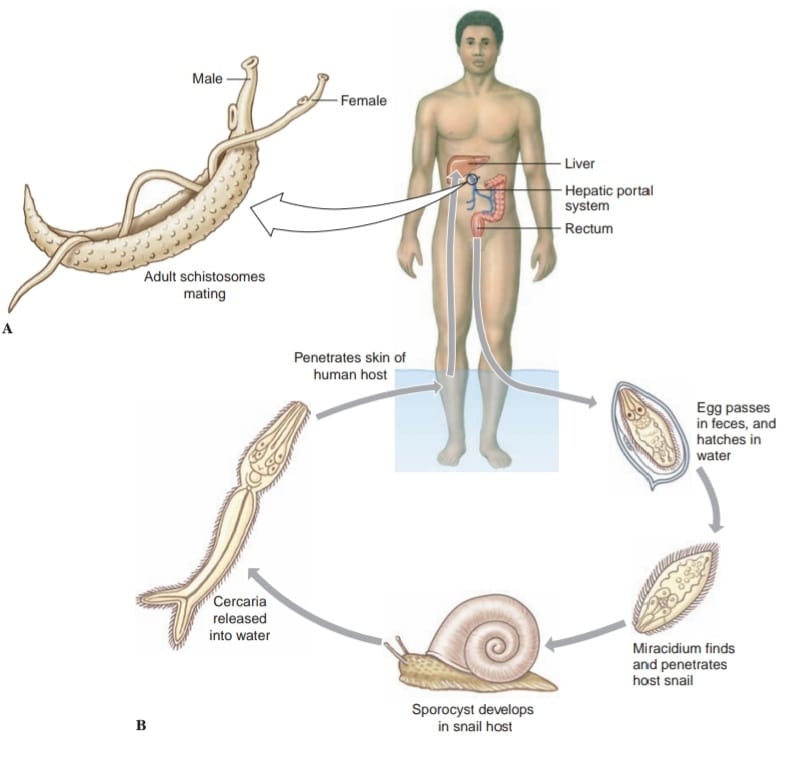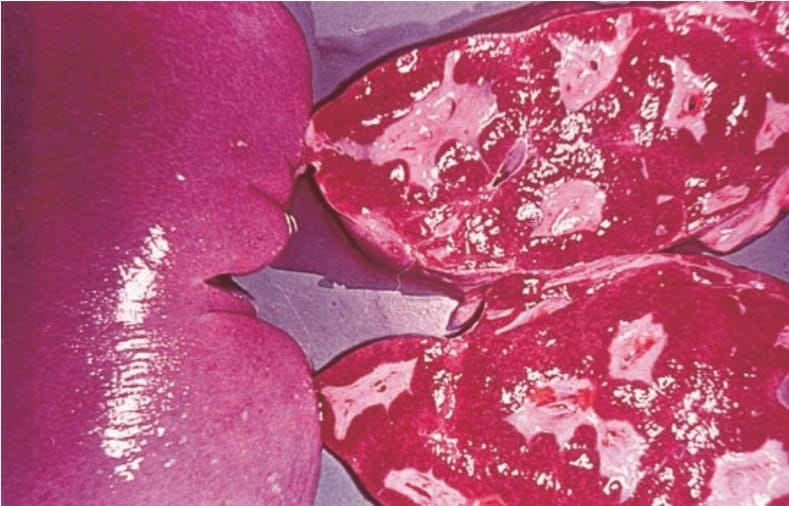Schistosomiasis, infection with blood flukes of genus Schistosoma (Gr. schistos,divided, + soma, body), ranks among the major infectious dis eases in the world, with 200 million people infected. The disease is widely prevalent over much of Africa and parts of South America, West Indies, Middle East, and Far East. The old generic name for the worms was Bilharzia (from Theodor Bilharz, German parasitologist who discovered Schistosoma haematobium), and the infection was called bilharziasis, a name still used in many areas. Blood flukes differ from most other flukes in being dioecious and having the two branches of the digestive tube united into a single tube in the posterior part of the body. Males are broader and heavier and have a large, ventral groove, the gynecophoric canal, posterior to the ventral sucker. The gynecophoric canal embraces the long, slender female.

Three species account for most schistosomiasis in humans: S. mansoni, which lives primarily in veins draining the large intestine; S. japonicum, which occurs mostly in veins of the small intestine; and S. haematobium, which lives in veins of the urinary bladder. Schistosoma mansoni is common in parts of Africa, Brazil, northern South America, and the West Indies; species of Biomphalaria are the principal snail intermediate hosts. Schistosoma haematobium is widely prevalent in Africa, using snails of the genera Bulinus and Physopsis as the main intermediate hosts. Schistosoma japonicum is confined to the Far East, and its hosts are several species of Oncomelania.
Unfortunately, some projects intended to raise the standard of living in some tropical countries, such as the Aswan High Dam in Egypt, have increased the prevalence of schistosomiasis by creating more habitats for the snail intermediate hosts. Before the dam was constructed, the 500 miles of the Nile River between Aswan and Cairo was subjected to annual floods; alternate flooding and drying killed many snails. Four years after dam completion, prevalence of schistosomiasis had increased sevenfold along that segment of the river. Prevalence in fishermen around the lake above the dam increased from a very low level to 76%.
The life cycle of blood flukes is similar in all species. Eggs are discharged in human feces or urine; if they get into water, they hatch as ciliated miracidia, which must contact the required kind of snail within a few hours to survive. In the snail, they transform into sporocysts, which produce another generation of sporocysts. Daughter sporocysts give rise to cercariae directly, without formation of rediae. Cercariae escape from the snail and swim until they contact bare human skin. They penetrate the skin, shedding their tails in the process, and reach a blood vessel where they enter the circulatory system. There is no metacercarial stage.
The young schistosomes make their way to the hepatic portal system of blood vessels and undergo a period of development in the liver before migrating to their characteristic sites. As eggs are released by adult females, they are somehow extruded through the wall of veins and through the gut or bladder lining, to be voided with feces or urine, according to species. Many eggs do not make this difficult transit and are swept by blood flow back to the liver or other areas, where they become centers of inflammation and tissue reaction.
The parasite’s eggs produce the main ill effects of schistosomiasis. With S. mansoni and S. japonicum, eggs in the intertinal wall cause ulceration, abscesses, and bloody diarrhea with abdominal pain. Similarly, S. haematobium causes ulceration of the bladder wall with bloody urine and pain on urination. Eggs swept to the liver or other sites cause symptoms associated with the organs where they lodge. When they are caught in the capillary bed of the liver, they impede circulation and cause cirrhosis, a fibrotic reaction that interferes with liver function . Of the three species, S. haematobium is considered least serious and S. japonicum most severe. The prognosis is poor in heavy infections of S. japonicum without early treatment. Control is best achieved by educating people to dispose of body wastes hygienically and to avoid exposure to contaminated water. These are difficult problems for poverty-stricken people living under unsanitary, crowded conditions.

Although proper disposal of body wastes is the best control for schistosomiasis, other strategies are being pursued with varying success: chemotherapy, vector control, and vaccination. Development of a vaccine is the subject of much research, but an effective vaccine is not yet available. Vector control by environmental management and by biological means appears promising. Biological controls include introduction of species of snails, crayfish, and fish that prey on the snail vectors. However, biological control attempts for other species have often been fraught with unexpected ecological impacts. In some cases, the biological control has been more of a problem in the long run than the pest species it was supposed to control. Many biologists consider such introductions an extreme risk that should be avoided.
Various species of schistosomes in several genera cause a rash or dermatitis when their cercariae penetrate hosts that are unsuitable for further development. Cercariae of several genera whose normal hosts are North American birds cause dermatitis in bathers in northern lakes. Severity of the rash increases with an increasing number of contacts with the organisms, or sensitization. After penetration, cercariae are attacked and killed by the host’s immune mechanisms, and they release allergenic substances, causing itching. The condition is more an annoyance than a serious threat to health, but there may be economic losses to vacation trade around infested lakes.
Useful External Links


